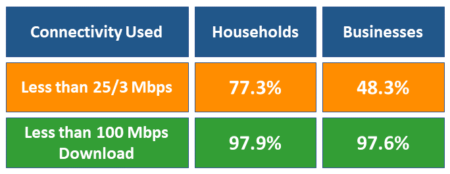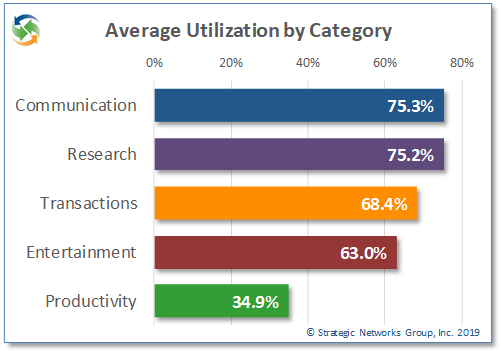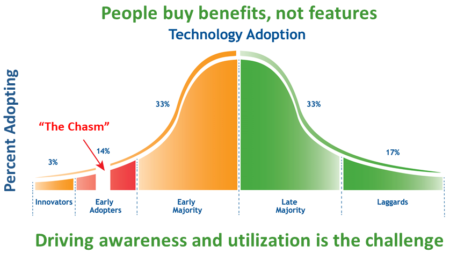Utilization – Driving Economic Impacts and Community Benefits through Broadband
The value of broadband comes from how it is used.
To advance your economy in a digital world, you must ensure that your local businesses, households, and organizations have the broadband they need plus the awareness and the capabilities to effectively use online practices (such as websites, online transactions, telework). This drives local economic impacts and community benefits.
How end users leverage technology is what we at SNG call ‘utilization’ – through a process of digital inclusion and transformation. For more than a decade we have studied how broadband and online practices impact businesses and people’s lives. In working with communities, regions, and states we have also assessed the costs of missing out from not having access, or not having the capability to effectively participate in an increasingly digital world. Below are some of our key research findings on the challenges most localities face and how they can overcome them to drive new local economic opportunities and improved quality of life through broadband and digital transformation.
Why does utilization matter?
- Utilization is a direct outcome of people’s awareness and capability to leverage technology and online practices (e.g. selling or buying online, teleworking, using social media).
- Showing people how they can benefit from the use of online practices drives demand for broadband and higher value services – this is part of the process for local digital transformation.
- The way people use broadband directly impacts their appreciation of its value, which further drives adoption of new technologies and online practices.
- SNG’s research shows that driving utilization to fully leverage technology (i.e. increasing digital maturity) delivers positive impacts, not only for the household or business user, but for the community overall in terms of economic impacts and quality of life benefits.
- For those investing in, or operating broadband networks, take rates and revenues are driven by the user perception of value from how they will use the services.
The Utilization Challenge
The challenge of digital transformation through broadband lies in two areas – 1) the prevalent use of low connection speeds, and 2) the underutilization of those connections.
1. Connectivity

Whether people choose low speeds, or just don’t have higher speeds available, their lack of connectivity is a problem because:
- Low take rates negatively impact a business case for providers, leaving the area to be unserved or underserved with broadband
- Low connectivity speeds hinder online access which restricts economic and civic participation in an increasingly digital world
2. Underutilization
Utilization and Digital Transformation

- 54.0% of households are underutilizing their internet connection (Digital Economy index less than 7.0)
- 49.9% of businesses are underutilizing their internet connection (Digital Economy index less than 7.0)
Low utilization is a problem because:
- Local businesses miss out on new ways of doing business and the accompanying revenue opportunities
- Local households miss out on better access to services (health, education, civic) and remote working opportunities, which negatively impacts their quality of life
- Businesses that are uncompetitive or that cannot be found online, will decline which negatively impacts the locality’s tax base and quality of life
- Service providers will not be as interested in markets where there does not appear to be enough demand
Solution – Drive Utilization to increase Digital Inclusion and Transformation
Change does not happen on its own. Digital transformation happens when the status quo is no longer acceptable.
To drive utilization, which then drives the demand for connectivity, you need to personalize the ROI (return on investment) of technology and digital transformation to businesses and households. Fundamentals of marketing and sales tell us in order to do that we need to first:
- know who they are
- understand what they are doing online, or should be doing online
- know why they are online (benefits)
SNG research answers these questions by:
- showing which online practices and new service offerings are required now, in the future, or are perceived not to be needed
- identifying barriers and assessing benefits to adopting new online practices
- uncovering preferences in bridging expertise and learning gaps
Rather than just asking people what connectivity they will subscribe to (which most people under-value based on SNG’s research), raise people’s awareness to help them understand what they could and should be doing online. This needs to be followed-up by providing training and technical assistance so they have the capability to leverage technology. This is foundational to digital inclusion and better ensuring digital equity.
These are the foundational elements in deploying a Digital Transformation Program whose goal is to help end users better leverage technology and online practices. Technology adoption research shows that these outcomes do not happen on their own for over 80% of the population. An ongoing process to drive digital transformation is needed, for the same reason we invest in schools and training – because without these investments we cannot maintain, nor grow our economies or quality of life.
Outcomes
By implementing a Digital Transformation Program, more people will become aware of what they could and should be doing online, plus they will have the capabilities to do so.
Bridging utilization gaps with 54% of households and 50% of businesses to fully leverage new technologies and online practices:
- Increases business and household benefits
- Increases local economic and community benefits
- Can stop and reverse out-migration and decline of the locality
- Drives higher take rates and subscriptions to higher value services
- Grows the market for higher value services and increases provider ARPU, which grows the business case for provider investment.
We call this a Digital Transformation Program because these outcomes do not happen on their own for over 80% of people. The results can be transformative for both households and businesses. As well, the community and local economy benefit overall through increased, purposeful utilization.
Measuring Utilization
For households SNG tracks 31 types of online practices and how they are used, broken down into five major categories:
- Communication, such as email, voice, web presence, online chats, etc.
- Research of information, such as health, community, travel, job search, educational material, government information, etc.
- Transactions online, from buying or selling items online to paying bills, online banking, and government services.
- Entertainment, including consuming news, movies, music, and videos online as well as gaming.
- Productivity uses such as teleworking, education and skills training, and home businesses.

For businesses, SNG tracks 17 types of online practices and how they are used. We measure the digital maturity of typical business practices that can be done, or augmented online. These online business practices broadly break down into two categories of use:
- eCommerce are those online business practices that tend to be externally facing, such as selling online, customer service, marketing, web presence, service delivery, and social media.
- eProcess are those online business practices that are more internally facing, such as purchasing, supply chain management, collaboration, employee training, and teleworking.
SNG has accumulated a Digital Economy Database of utilization and related information from more than 75,000 households and businesses. SNG’s research shows that different people will use broadband and online practices to different degrees. Some will use technology to its fullest capacity while others will use it minimally for only the basics.
When better broadband is made available in a locality people will sign up. However SNG’s research shows that 50% of businesses and 54% of households underutilize the internet connection they have.
While the innovators and early adopters will subscribe to higher service packages and have high utilization, they represent only 18-25% of the market – which is not enough for a sustainable business case. The majority of commercial and residential subscribers are underutilizing their internet connections because they lack capability and have low awareness of what is possible – in other words “they don’t know what they don’t know”. This is true for both businesses and households. This represents a significant opportunity cost to the local economy and community’s quality of life through unrealized revenues, outmigration, foregone jobs, reduced tax base, etc.
Understanding broadband utilization and what households and businesses need enables you to meet those needs and leverage the power of broadband.
Learn more about how to drive utilization for economic growth
Digital Transformation Program
Help your local businesses, households, and organizations have the broadband they need and the capabilities to use it.
Learn how SNG’s Digital Transformation Program can develop a plan that converts market potential into broadband demand and economic growth.
Small Business Growth Program
Help businesses grow through understanding how online practices create income and competitiveness.
Learn more about SNG’s Small Business Growth Program and how you can help your business community be even more successful.


